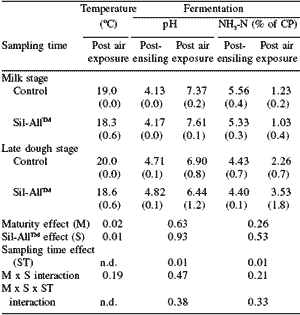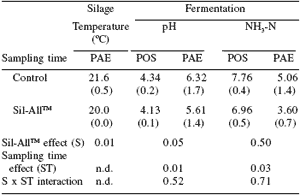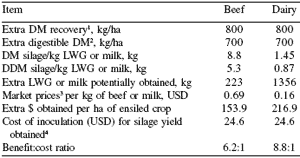Evaluating inoculants for forage crops in Argentine beef and milk grazing systems: effects on silage quality and system profitability
Due to the high quality of pastures and relatively low silage inclusion in Argentine diets (<30%, DM basis), good animal performance was obtained when silages supplemented pastures compared with ad libitum grazing, as shown by Abdelhadi et al. (2001; 2003) and Abdelhadi and Santini (2003). An increased stocking rate is the only benefit of corn or grain sorghum silage supplementation of pasture.• Less dependence on weather compared with hay.
• Nutrient content maintained, similar to field crop.
• Higher DM production at low cost compared with grains.
Nevertheless, Argentina’s producers are far from having the high quality silages needed in order to justify increasing silage use in rations or to replace concentrate in diets fed high producing animals. If we analyze corn silage, one of the easier crops for making good silage due to its high water soluble carbohydrate (WSC): buffering capacity (BC) ratio, it is clear that digestibility coefficients are lower than in other countries, from a crop of about 75% in vitro dry matter digestibility (IVDMD) at harvest stage (Figure 1).
There are three major events for making good silage: 1) exclusion of air before sealing the silo (generally depends on contract workers); 2) rapid rate and extent of pH drop (depends on the extent of fermentation); and 3) storage phase (depends on farmer management) (Kung, 2001).

Figure 1. Corn silage in vitro DM digestibility (IVDMD) around the world (Data from: Schroeder et al., 2000; INRA, 1989; Roth and Undersander, 1995; Deinum and Struik, 1985; De Boever et al., 1997).
The data in Figure 1 come from samples taken in the silo, not in the feedbunk, and so are the result of Events 1 and 2. Because the work of contractors is often difficult for the farmer to manage, our research was directed at controlling the fermentation process.
Together with representatives from Alltech Argentina and Monsanto, we conducted a series of studies to evaluate utilization of Sil-AllTM inoculant to increase quality of ensiled crops and hence animal production and profitability of pasture based systems at the El Encuentro farm (35°23´S; 58°25´W). Effects of Sil-AllTM inoculation on fermentation and nutritive value of grain sorghum (whole head) ensiled at two stages of maturity
METHODS
The same grain sorghum hybrid was seeded on December 3 and 20, 2002 on a commercial dairy farm (El Recuerdo). Harvest occurred on March 26, 2003, therefore we had the same cultivar at two stages of maturity (milk and dough stages). A Class Jaguar 860 harvester equipped with a grain cracker was used; and the chop length was 7.9 mm. Within 30 min of chopping, samples of fresh material from each stage of maturity were frozen and triplicate mini silos constructed of PVC pipe (10 x 39 cm) were made with or without Sil-AllTM inoculation. Weights of silos both empty and full were recorded, and silos were then stored at ambient temperature of about 15 to 20ºC. After a three month storage period (from March to June, 2003) final weights of the full silos were recorded and the silage was hand-mixed thoroughly. Dry matter (DM) recovery was calculated as in Kung et al. (2003) and pack density in each mini silo was estimated as in Johnson et al. (2002). Approximately 50% of the mixed material was frozen and the remainder was exposed to air for three days after which samples were frozen. Frozen samples of each material pre-ensiling (PRE), post-ensiling (POS) and post-air exposure (PAE), were oven-dried (60ºC), ground through a 1 mm screen (Willey Mill, Philadelphia, PA) and analyzed for DM, in vitro organic matter (OM) degradability (Villalba, 2001), WSC (Bailey, 1958), crude protein (CP) (Horneck and Miller, 1998) and NDF (van Soest, 1991); plus pH (Cole Parmer portable pH meter) and ammonia- N (NH3-N) (Weatherburn, 1967) in POS and PAE samples. Statistical analysis was conducted using the general linear model in SAS (1989) using a completely randomized design with a 2 x 2 factorial arrangement (two stages of maturity with or without Sil-AllTM inoculation).
RESULTS
DM recovery and fermentation
A maturity x inoculant interaction was found (P<0.06) for DM recovery. Inoculation increased (P<0.08) silage DM recovery from 92.4% (control) to 97.9% in silages harvested at the milk stage of maturity, while no effect was noted (P<0.25) in silage harvested at the dough stage.
Parameters associated with silage fermentation are presented in Table 1. Sil-AllTM inoculation decreased silage temperature after three days of air exposure (P<0.01) by 0.7 and 1.4 ºC for milk and late dough grain stages of maturity, respectively. No effects of inoculation were detected for pH (P<0.93) or NH3-N (P<0.53), while air exposure increased pH and decreased NH3-N of silages at either stage of maturity (P<0.01).
Table 1. Sil-AllTM effects on temperature and silage fermentation of grain sorghum (whole head) at milk or late dough stages of maturity1.

1TreaTMent means (± standard deviation) Nutrient content and in vitro degradability Neither DM, CP nor NDF concentration were affected by inoculation, while WSC in silage increased with Sil-AllTM (P<0.05) (Table 2).
Significant maturity effects were detected for nutrient concentrations in pre-ensiled samples (P<0.01), which underscores the importance of defining harvest time for grain sorghum silage.
In vitro OM degradability was determined after incubation of PRE, POS and PAE samples with ruminal fluid (Table 3). No significant effects of Sil- AllTM inoculation were noted across the entire incubation time (P<0.5), but depending on time of incubation, increases in degradability from 3 to 5 points were noted and should be considered from an economic point of view. Again, increased maturity negatively influenced quality of material at ensiling.
Table 2. Sil-AllTM effects on nutrient concentration of whole-head grain sorghum silage at milk or late dough stages of maturity 1,2,3.

To enlarge the image, click here
1TreaTMent means (± standard deviation); 2PRE= pre-ensiling, POS= post-ensiling, PAE= after 3 days air exposure 3DM= dry matter, WSC= water soluble carbohydrates, CP= crude protein, NDF= neutral detergent fiber
Table 3. Sil-AllTM effects on in vitro organic matter degradability of whole-head grain sorghum silage at milk or late dough stages of maturity 1,2.

To enlarge the image, click here
1TreaTMent means (± standard deviation); 2PRE= pre-ensiling, POS= post-ensiling, PAE= after 3 days air exposure
Effects of Sil-AllTM inoculation on fermentation and nutritive value of whole-plant grain sorghum silage
METHODS
Grain sorghum (MS2, Morgan hybrid) was direct seeded on December 5, 2002 at the Los Aromos dairy farm (35º10´S; 58º14´W). Harvesting occurred on March 27, 2003 when grain was at the milk stage. Ensiling, sampling methods and quality determinations were as in the first experiment. Data were analyzed as a completely randomized design and treaTMent comparisons were obtained by ANOVA using the PROC GLM procedures of SAS (1988).
RESULTS
DM recovery and fermentation
Dry matter recovery was not statistically different, however the numerical increase from 92.1% (control) to 95.1% with Sil-AllTM inoculation could be of economic relevance. Temperature after three days exposure to air was unaffected (P<0.34) by inoculation, as were pH and NH3-N values (Table 4).
Nutrient content and in vitro degradability
There were no significant effects of inoculation on nutrient quality of silage samples taken either after fermentation or following aerobic exposure (Table 5). In vitro OM degradability of air-exposed silage was lower than the pre-ensiled samples (P<0.01) (Table 6). Depending on time of incubation, Sil-AllTM tended to reduce losses in degradability (by 3.5 points).
Table 4. Sil-AllTM effects on temperature and silage fermentation of whole-plant grain sorghum silage at the milk stage of maturity 1,2.

1TreaTMent means (± standard deviation).
2POS= post-ensiling, PAE= after 3 days air exposure
Table 5. Sil-AllTM effects nutrient concentration of whole-plant grain sorghum silage at milk stage of maturity1,2,3.

To enlarge the image, click here
1TreaTMent means (± standard deviation)
2PRE= pre-ensiling, POS= post-ensiling, PAE= after 3 days air exposure
3DM= dry matter, WSC= water soluble carbohydrates, CP= crude protein, NDF= neutral detergent fiber
Table 6. Sil-AllTM effects on in vitro organic matter degradability of whole-plant grain sorghum silage at milk stage of maturity 1,2.

To enlarge the image, click here
1TreaTMent means (± standard deviation)
2PRE= pre-ensiling, POS= post-ensiling, PAE= after 3 days air exposure
Effects of Sil-AllTM inoculation on fermentation and nutritive value of whole-plant corn silage
METHODS
Corn (M369, Morgan hybrid) was seeded on October 25, 2002 in Los Aromos dairy farm (35º10´S; 58º14´W). Ensiling, sampling methods and quality determinations were as in the previous experiments, but harvest occurred at the late dough stage of maturity on March 27, 2003. Statistical analysis was as in the second experiment.
RESULTS
DM recovery and fermentation
Inoculation with Sil-AllTM increased DM recovery (P<0.05) from 94.5% (control) to 99.6%. The added 5.1 percentage points represents a large amount of forage. Sil-AllTM inoculation decreased pH (P<0.05) measured in samples taken either after silage fermentation or after aerobic exposure (Table 7). Heating was also reduced in the inoculated silage by 1.6ºC. Ammonia-N tended to be lower in inoculated silage but was not statistically different.
Table 7. Sil-AllTM effects on temperature and silage fermentation of whole-plant corn silage at late dough stage of maturity1,2.

1TreaTMent means (± standard deviation).
2POS= post-ensiling, PAE= after 3 days air exposure
Nutrient content and in vitro degradability
A significant increase in DM percentage (P<0.02) and decreased NDF content (P<0.09) were detected in inoculated corn silage (Table 8). Neither WSC nor CP concentrations were affected by inoculation. A trend toward increased in vitro OM degradability was detected after 48 (P<0.19) and 72 hrs (P<0.17) of incubation in Sil-AllTM-treated material (Table 9). The added 3.5% digestible material is similar to values reported for grain sorghum silage.
Table 8. Sil-AllTM effects on nutrient concentration of whole-plant corn silage at late dough grain stage of maturity 1,2,3.

To enlarge the image, click here
1TreaTMent means (± standard deviation); 2PRE= pre-ensiling, POS= post-ensiling, PAE= after 3 days air exposure;
3DM= dry matter, WSC= water soluble carbohydrates, CP= crude protein, NDF= neutral detergent fiber
Table 9. Sil-AllTM effects on in vitro organic matter degradability of whole-plant corn silage at late dough stage of maturity1,2.

To enlarge the image, click here
1TreaTMent means (± standard deviation); 2PRE= pre-ensiling, POS= post-ensiling, PAE= after 3 days air exposure
Economic evaluation of Sil-AllTM inoculation for Argentine systems
Because silage inclusion in beef and dairy cattle diets in Argentina is only moderate (<30%, DM basis) less benefit will be achieved when increasing silage quality than in other feeding systems. The chief benefit of inoculation in the Argentine system is the added DM recovery, which along with improved silage quality, has the potential to increase animal production and hence economic return.
To calculate profitability of a silage inoculation program for Argentina, we considered DM recoveries and increases in degradability obtained. These data were transformed to extra animal live weight gain (LWG) or milk production using the following criteria:
1) 8.8 kg DM of silage = 1 kg LWG/ha and 5.3 kg digestible DM (DDM) = 1 kg LWG/ha in grazing beef cattle (Abdelhadi et al., 2001; 2003; Abdelhadi and Santini, 2003).
2) 1.45 kg DM of silage = 1 kg milk and 0.87 kg DDM = 1 kg milk in grazing dairy cows (Abdelhadi et al., 2001) (using a mean digestibility of about 60% (DM basis) generally obtained in commercial farms) (Table 10).
Finally, the cost of inoculation was deducted from extra return to obtain the benefit:cost ratio. Benefit:cost ratios of 6.5:1 (beef) and 8.8:1 (dairy) USD per hectare of grain sorghum or corn ensiled were obtained (Table 10).
Table 10. Benefit:cost ratio of Sil-AllTM inoculation in ensiled corn or sorghum silages for supplementing grazing beef or dairy cattle.
1 Mean production DM/ha for sorghum and corn = 20 tons, considering DM recovery of 5% extra by inoculation.
2 Mean production DDM/ha for sorghum and corn = 12 tons, considering an extra of digestible DM of 3.5 points which is 5.83% extra of DDM/ha.
3 Expressed in USD, considering local money exchange of 2.9 Argentinean pesos = $1.
4 Mean of about 60 tonnes of fresh material per hectare.
Conclusions
Even though ensiling grain sorghum and maize is easier due to higher WSC:BC ratio, significant losses have been quantified in Argentine silos. These experiments were conducted to evaluate the Sil-AllTM inoculant as a management tool to reduce such losses.
Data obtained showed increased DM recovery and in vitro OM degradability of ensiled crops when Sil- AllTM was used. In addition, a better fermentation pattern and lower NDF content was reported depending on crop evaluated. Since silages in Argentina supplement grazing cattle, we evaluated these increases in terms of quantity and quality in economic terms, finding a benefit:cost ratio of 6.5:1 (beef) or 8.8:1 (dairy) USD per hectare of grain sorghum or corn ensiled. These results will give farmers the technical and economic information needed to implement an inoculation program for pasture-based systems.
References
Author: LEANDRO O. ABDELHADIAbdelhadi, L.O., F.J. Santini and G.A. Gagliostro. 2001. Whole plant silage as a supplement for grazing cattle: Effects on productive performance and ruminal environment. Rev. Arg. Prod. Anim. 21(3-4):147-158.
Abdelhadi, L.O., F.J. Santini and G.A. Gagliostro. 2003. Corn silage or high moisture corn supplements for beef heifers grazing temperate pastures: Effects on performance, ruminal fermentation and in situ pasture digestion. Anim. Feed Sci. and Tech. (In press).
Abdelhadi, L.O. and F.J. Santini. 2003. Replacing corn silage with grain sorghum silage to supplement growing steers grazing high quality pastures: Effects on performance and ruminal fermentation. Anim. Feed Sci. and Tech. (In press).
Bailey, R.W. 1958. Reactions of pentoses with anthrone. Bioch. J. 68:669.
De Boever, J.L., B.G. Cottyn, D.L. De Brabander, J.M. Vanacker and Ch.V. Boucqué. 1997. Prediction of feeding value of maize silages by chemical parameters, in vitro digestibility and NIRS. Anim. Feed Sci. and Tech. 66:211.
Deinum, B. and P.C. Struik. 1985. Improving the nutritive value of forage maize. Proc. 13th Congress of the Maize and Sorghum Section of Eucarpia, September 9-12, 1985, Wageningen. The Netherlands, pp. 77-90.
Horneck, A.D. and R.O. Miller. 1998. Determination of total nitrogen in plant tissue. In: Handbook of Reference Methods for Plant Analysis (Y.P. Kalra, ed). Soil and Plant Analysis Council, Inc. CRC Press, p. 300.
Institut Nationale Recherche Agronomique (INRA). 1989. Ruminant nutrition. Recommended allowances and feed tables (R. Jarrige, ed). Paris: INRA, p. 389.
Johnson, L.M., J.H. Harrison, D. Davidson, W.C. Mahanna, K. Shinners and D. Linder. 2002. Corn silage management: Effects of maturity, inoculation and mechanical processing on pack density and aerobic stability. J. Dairy Sci. 85:434-444.
Kung, L., Jr. 2001. Silage fermentation and additives. In: Proceedings of Alltech’s 17th Annual Symposium. (K.A. Jacques and T.P. Lyons, eds). Nottingham University Press, Nottingham, UK, pp. 145-159.
Kung, L., Jr., C.C. Taylor, M.P. Lynch and J.M. Neylon. 2003. The effect of treating alfalfa with Lactobacillus buchneri 40788 on silage fermentation, aerobic stability and nutritive value for lactating dairy cows. J. Dairy Sci. 86:336-343.
Roth, G.W. and D. Undersander. 1995. Corn silage production, management and feeding. American Society of Agronomy, Inc., Crop Science Society of America, Inc. and Soil Science of America, Inc., p. 42.
SAS. 1989. SAS/STAT User’s Guide: Ver. 6, 4th Ed., Vol. 2, Cary NC: SAS Institute Inc.
Schroeder, G.F., J.C. Elizalde and J.P. Fay. 2000. Characterization of the nutritive value of corn silage produced in Buenos Aires province. Rev. Arg. Prod. Anim. 20(3-4):161-177.
van Soest, P.J., J.B. Robertson and B.A. Lewis. 1991. Methods for dietary fiber, neutral detergent fiber and nonstarch polysaccharides in relation to animal nutrition. In: Proceedings of the Symposium on Carbohydrate Methodology, Metabolism, and Nutritional Implications in Dairy Cattle. J. Dairy Sci. 74: 3583-3597.
Villalba, S.E. 2001. Producción de gas in vitro. Uso de la técnica para estimar la degradabilidad de los alimentos para rumiantes. Trabajo final de graduación. Facultad de bromatología UNER. Weatherburn, M.W. 1967. Phenol-hypochlorite reactions for determination of ammonia. Anal. Chem. 39:971-974.
El Encuentro Livestock Farm, Research & Extension in Ruminant Nutrition, Alltech Argentina, Cnel. Brandsen, Argentina





.jpg&w=3840&q=75)